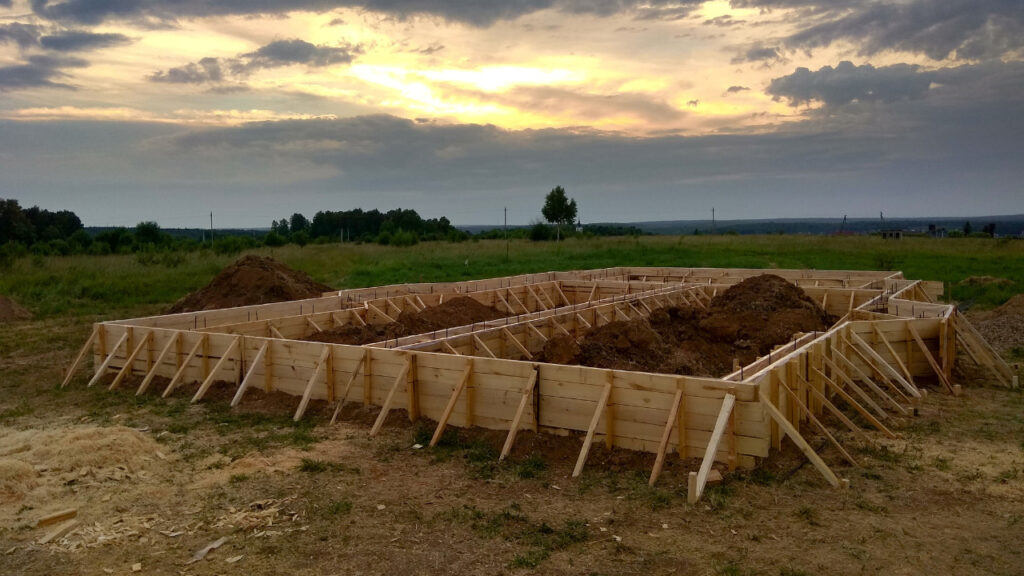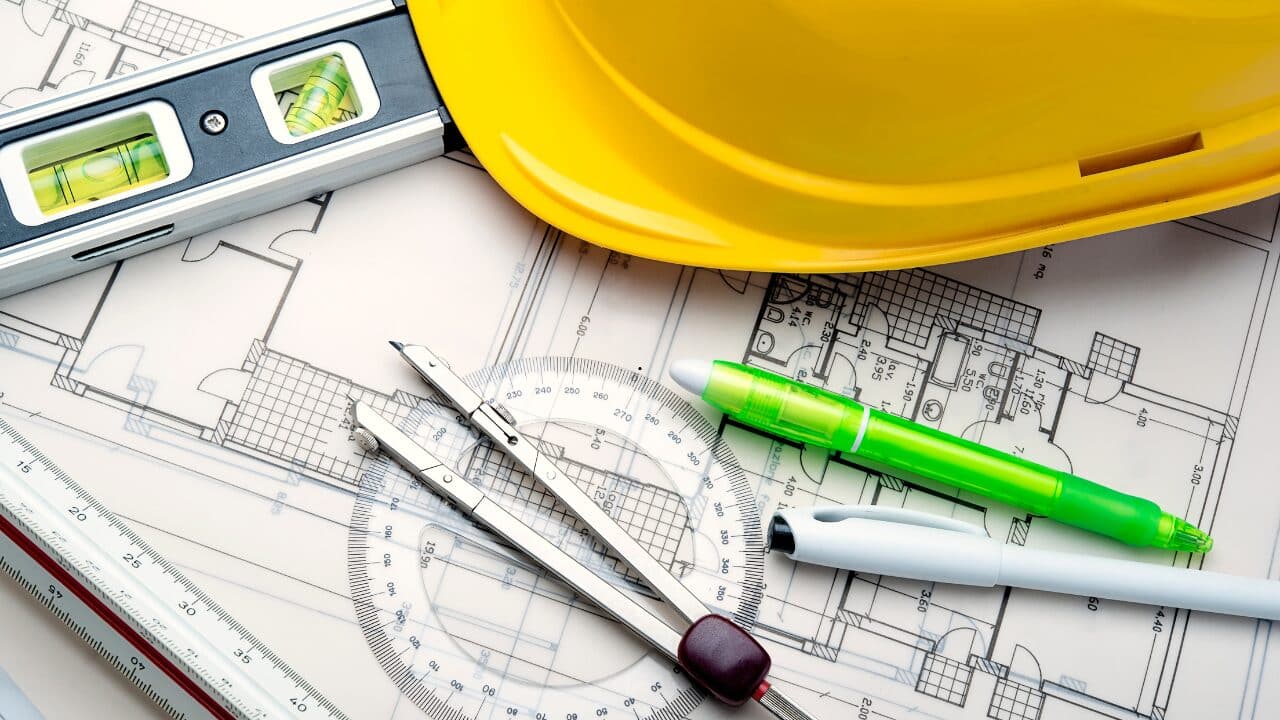One of the most important factors to take into account when building a solid and stable structure is selecting a foundation. One particularly well-liked option is trench fill foundations, which provide a sturdy way to support the weight of a building while preserving its structural integrity.
In this blog, we will discuss trench fill foundations in detail and understand their advantages/disadvantages, depth considerations, and comparison with strip foundations.
Table of Contents
What is a Trench Fill Foundation?
Fundamentally, a trench fill foundation is a kind of shallow foundation that intends to distribute a building’s weight across the ground equally.
Trench fill foundations entail filling the entire trench with concrete than the traditional strip foundations, which feature a continuous strip of concrete along the load-bearing walls. This technique lowers the possibility of differential settlement by ensuring a more even load distribution.
3 Key Components of Trench Fill Foundations
Trench fill foundation essentials are crucial parts that come together to form a strong and stable foundation for a building. Comprehending these components is essential in guaranteeing the efficacy and durability of the foundation.
Let’s examine each essential component in more detail:
1. Concrete Fill
The main component used in trench fill foundations is concrete fill, which acts as the structure’s foundational support. It offers the strength required to evenly distribute the building’s weight across the ground.
In trench fill foundations, concrete is usually composed of a mixture of cement, aggregates (like gravel and sand), and water. Various factors, such as soil conditions, structural requirements, and local building codes, may affect the specific mix design.
The concrete mix is poured into the trench once it has been dug out to the necessary depth. It is imperative to guarantee that the concrete is thoroughly compacted and devoid of any air spaces, since any flaws may jeopardize the stability of the foundation.
2. Reinforcement Bars (Rebar)
To increase the tensile strength of the concrete, reinforcement bars, or rebar, are added to the mixture. Concrete cracks under tension even though it performs exceptionally well in compression. Rebar adds more strength and support, which helps to lessen this.
Rebar is deliberately inserted into the concrete fill, usually in the form of a grid. The load-bearing capacity and structural specifications for a given project determine the rebar’s size and spacing.
Steel is usually used for rebar because of its strength and longevity. Rebar steel is frequently corrosion-resistant, particularly in areas that are exposed to extreme weather or high levels of moisture.
3. Excavation Process
One of the most important parts of trench fill foundations is excavation. To avoid frost heave, which is the phenomenon where the ground expands as a result of freezing temperatures, the trench needs to be dug to a depth that is below the frost line.
The process of professional excavation entails removing dirt to make a trench the necessary length and depth. After the foundation is installed, the removed soil is either backfilled or temporarily stored.
You should do the excavation process precisely to ensure the foundation is even and level. Any imperfections or inconsistencies in the trench could impact the way the load is distributed and jeopardize the stability of the building.

Pros and Cons of Trench Fill Foundation
Trench fill foundations have pros and cons of their own, just like any other type of foundation. Making wise decisions during a construction project’s planning and execution stages requires understanding these variables.
Let’s walk through the pros and cons of the trench fill foundations:
Pros of Trench Fill Foundation
- Decreased Risk of Differential Settlement: Over time, uneven settlement can cause structural problems, but it is reduced when the load is evenly distributed throughout the trench.
- Time-Efficient Construction: Trench fill foundations are a good choice for projects with short timelines because they can be built more quickly than traditional strip foundations.
- Increased Structural Stability: Trench fill foundation depth and homogeneity, particularly in regions with difficult soil conditions, contribute to increased stability.
Cons of Trench Fill Foundation
- Costs of Materials and Labour: Compared to other foundation types, the use of a large quantity of concrete and reinforcing materials may result in higher costs of materials and labor.
- Difficulties in Excavation: Excavation work for trench fill foundations can be more difficult, especially in places with rocky or uneven terrain. This could make the construction process more complicated.
- Restricted Adaptability: Not all types of soil conditions will be best suited for trench fill foundations. Different types of foundations may be more flexible in certain situations.
4 Factors Influencing the Depth of the Trench Fill Foundations
Trench fill foundation depth is an important factor that needs to be carefully taken into account during the planning stage. A suitable depth guarantees stability and averts problems like differential settlement and frost heave.
Here are the factors influencing the depth of the trench fill foundations:
1. Type of the Soil
The necessary depth is mostly dependent on the kind of soil present at the construction site. For example, in regions with expansive clay soils, heaving may be avoided by digging a deeper trench.
2. Load-Bearing Capacity
The requirements for depth are influenced by the weight and design of the structure. Deeper trench fill foundations are typically required for heavier structures to support the increased load.
3. Frost Line
A minimum depth below the frost line that the trench must reach is frequently specified by building codes. It lessens the chance of frost heave, a phenomenon where freezing temperatures cause the ground to expand.
4. Site Conditions
Trench depth requirements can be influenced by the overall topography and conditions of the construction site, including the presence of nearby trees or water tables.
3 Essential Guidelines for Determining Trench Depth
Before moving forward with the trench fill foundation, understand these essential guidelines to determine the depth of the trench:
1. Check Local Building Codes
Local building codes differ depending on where you live, so it’s important to follow the rules about the depth of the foundation. The purpose of these codes is to guarantee the stability and safety of structures.
2. Assessment by a Structural Engineer
Having a structural engineer evaluate the project’s particular needs can give important information about the ideal trench depth depending on the site’s features and the structure’s design.
3. Geotechnical Study
To determine the ideal trench depth, a geotechnical study of the site is necessary to determine the soil conditions and potential difficulties.
Trench Fill Foundations vs. Strip Foundations
The decision between trench fill and strip foundations is influenced by many variables, such as project timelines, soil conditions, and load-bearing capacity.
Making wise choices in the early phases of construction planning requires understanding the distinctions between these two types of foundations.
Let’s have a look at that:
Trench Fill Foundations
- Even Distribution of Loads: Trench fill foundations are excellent at evenly distributing loads throughout the whole trench, reducing the chance of differential settlement.
- Appropriate for Hard Soil Conditions: Trench fill foundations can offer improved stability in regions with hard soil conditions, like expansive clay.
- Faster Construction: Trench fill foundations can be built more quickly than strip foundations, which is helpful for projects with constrained time frames.
Strip Foundations
- Cost-Effective: Strip foundations are a better option for projects on a tight budget because they are typically less expensive to construct and use in terms of labor and materials.
- Adaptable to Different Soil Types: Strip foundations are a dependable choice in a broad range of construction scenarios due to their versatility and ability to be adapted to different soil conditions.
- Widespread Use: Many builders and engineers choose strip foundations because they are a common and well-understood option in the construction industry.

Building a Solid Foundation Starts with Knowledge
With their focus on stability, load distribution, and adaptability to difficult soil conditions, trench fill foundations present a compelling alternative for many construction projects. The art of trench fill foundations continues to be essential in the search for solid and durable structures as engineers and builders look for new and efficient ways to solve problems.
Construction professionals can ensure that their buildings are more than just structures by becoming knowledgeable about the ins and outs of trench fill foundations. It will help them make decisions that will last over time and leave a legacy of durability and endurance.





